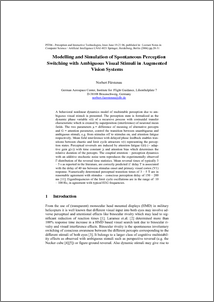|
|
Modelling and Simulation of Spontaneous Perception Switching with Ambiguous Visual Stimuli in Augmented Vision Systems
Fürstenau, Norbert
(2006)
Modelling and Simulation of Spontaneous Perception Switching with Ambiguous Visual Stimuli in Augmented Vision Systems.
Lecture Notes in Computer Science, 4021, Seiten 20-31.
Springer.
ISSN 0302-9743.
![[img]](https://elib.dlr.de/style/images/fileicons/application_pdf.png)  Vorschau |
|
PDF
587kB |
KurzfassungA behavioral nonlinear dynamics model of multistable perception due to ambiguous visual stimuli is presented. The perception state is formalized as the phase variable (order parameter) of a recursive cosinuidal map with the two control parameters μ= difference of meaning and G ~ attention. μ controls the transition between unambiguous and ambiguous stimuli, e.g. from stimulus off to stimulus on, by means of a node bifurcation. Neuronal mean field interference with delayed phase feedback, with gain G, delay T, and damping time τ enables transitions between chaotic and limit cycle attractors representing the perception states. Quasiperiodic perceptual reversals are induced by attention satiation (fatigue) G(t) with time constant γ and attention bias which determines the relative duration of the different percepts. The coupled attention – percep-tion dynamics with an additive stochastic attention noise term reproduces the experimentally observed Γ-distribution of the reversal time statistics. Mean reversal times of typically 3 – 5 s as reported in the literature, are correctly predicted if T is associated with the delay of 40 ms between stimulus onset and primary visual cortex (V1) response. Numerically determined perceptual transition times of 3 – 5 T are in reasonable agreement with stimulus – conscious perception delay of 150 – 200 ms [11]. Eigenfrequencies of the limit cycle oscillations are in the range of 10 – 100 Hz, in agreement with typical EEG frequencies. | elib-URL des Eintrags: | https://elib.dlr.de/75159/ |
|---|
| Dokumentart: | Zeitschriftenbeitrag |
|---|
| Titel: | Modelling and Simulation of Spontaneous Perception Switching with Ambiguous Visual Stimuli in Augmented Vision Systems |
|---|
| Autoren: | | Autoren | Institution oder E-Mail-Adresse | Autoren-ORCID-iD | ORCID Put Code |
|---|
| Fürstenau, Norbert | NICHT SPEZIFIZIERT | NICHT SPEZIFIZIERT | NICHT SPEZIFIZIERT |
|
|---|
| Datum: | 2006 |
|---|
| Erschienen in: | Lecture Notes in Computer Science |
|---|
| Referierte Publikation: | Ja |
|---|
| Open Access: | Ja |
|---|
| Gold Open Access: | Nein |
|---|
| In SCOPUS: | Ja |
|---|
| In ISI Web of Science: | Nein |
|---|
| Band: | 4021 |
|---|
| Seitenbereich: | Seiten 20-31 |
|---|
| Herausgeber: | | Herausgeber | Institution und/oder E-Mail-Adresse der Herausgeber | Herausgeber-ORCID-iD | ORCID Put Code |
|---|
| André, Elisabeth | NICHT SPEZIFIZIERT | NICHT SPEZIFIZIERT | NICHT SPEZIFIZIERT | | Dybkjaer, Laila | NICHT SPEZIFIZIERT | NICHT SPEZIFIZIERT | NICHT SPEZIFIZIERT | | Minker, Wolfgang | NICHT SPEZIFIZIERT | NICHT SPEZIFIZIERT | NICHT SPEZIFIZIERT | | Neumann, Heiko | NICHT SPEZIFIZIERT | NICHT SPEZIFIZIERT | NICHT SPEZIFIZIERT | | Weber, Michael | NICHT SPEZIFIZIERT | NICHT SPEZIFIZIERT | NICHT SPEZIFIZIERT |
|
|---|
| Verlag: | Springer |
|---|
| Name der Reihe: | Lecture Notes in Artificial Intelligence (LNAI) |
|---|
| ISSN: | 0302-9743 |
|---|
| Status: | veröffentlicht |
|---|
| Stichwörter: | cognitive multistability, ambiguous stimuli, perception state, attention, perception reversal, dynamical system, nonlinear dynamics, phase oscillator, deterministic chaos, gamma distribution |
|---|
| HGF - Forschungsbereich: | Luftfahrt, Raumfahrt und Verkehr |
|---|
| HGF - Programm: | Luftfahrt |
|---|
| HGF - Programmthema: | ATM und Flugbetrieb (alt) |
|---|
| DLR - Schwerpunkt: | Luftfahrt |
|---|
| DLR - Forschungsgebiet: | L AO - Luftverkehrsmanagement und Flugbetrieb |
|---|
| DLR - Teilgebiet (Projekt, Vorhaben): | L - Faktor Mensch und Sicherheit in der Luftfahrt (alt) |
|---|
| Standort: |
Braunschweig
|
|---|
| Institute & Einrichtungen: | Institut für Flugführung > Systemergonomie |
|---|
| Hinterlegt von: |
Fürstenau, Dr.phil.nat. Norbert
|
|---|
| Hinterlegt am: | 12 Nov 2013 11:51 |
|---|
| Letzte Änderung: | 24 Apr 2024 19:41 |
|---|
Nur für Mitarbeiter des Archivs: Kontrollseite des Eintrags
|
|